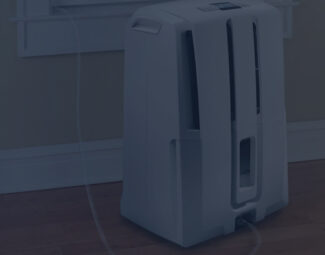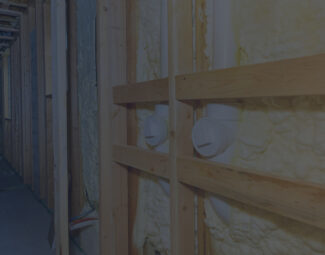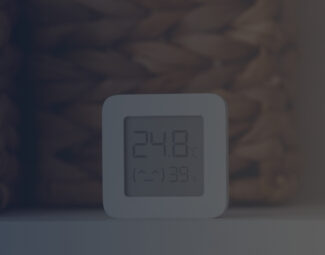L iving in a damp space where humidity exceeds the recommended level isn’t only unbearable as comfort is compromised, but it can be quite dangerous as well. A solution most people opt for in this case is the dehumidifier, an appliance that promises to reduce moisture through its operation.
While these systems can be found at prices to suit all budgets, most of them are pricey, especially those that come with essential features and options that add to their performance prowess. As costs are generally high, the question inevitably rises – is buying a dehumidifier worth it? Let’s find out the answer to this question together in the following and see if a humidity reduction system is suited for your situation or not.

High Indoor Air Humidity Causes Condensation
What is high humidity?
While the definition of humidity refers to the amount of vapor present in the air, when referring to high humidity, there are a few ways to define it, depending on the source you rely on. The EPA rates humidity levels above 50% as being high, whereas most scientists agree upon 60% and up to represent a high level.
What causes humidity?
Sources and reasons are plenty and vary from one household to another, some even being specific for certain areas of the house. Nonetheless, taking a general look at the causes, some are common for most situations. For example, bathrooms fall prey to high RH levels quite easily as vapors form excessively when you shower, and most of the time, exhaust vents aren’t capable of expelling the steam in the nick of time or well enough either. Kitchens aren’t far behind either considering that most recipes involve boiling, which leads to water evaporating.
Drying laundry inside is frowned upon without the use of a dehumidifier as a single load can release an estimated 2 liters of extra water into the air. If the basement has porous walls or there are leaks in the plumbing, this too leads to RH rising dangerously. The area you live in impacts air moisture as well. Those who live in heavy rainfall regions, high humidity regions, and coastal regions are prone to confronting this issue.
What are the repercussions of high humidity indoors?
- Favorable conditions are created for the growth and development of mold and mildew;
- Condensation forms on windows and walls, and could affect the windowsills;
- Aggravation in the symptoms of individuals who suffer from asthma and allergies;
- The structure of the building is compromised in case humidity exceeds normal parameters and isn’t resolved, which puts you at great risk;
- A general feeling of discomfort is felt indoors as damp spaces tend to make you feel hot and make breathing more difficult.
Does high humidity cause allergy symptoms to act up?
Short answer – yes, it does! How is that exactly? Well, some of the most common allergenic particles are mold spores, mildew, and dust mites, and they all thrive in muggy spaces. Thus, regardless if your home suffers from high moisture or you live in an area with a humid climate, you will experience allergies worse than you would when air moistness would be kept in check. If you don’t tend to the issue, expect to experience watery and itchy eyes, skin rashes, irritations, sneezing, trouble breathing, a stuffy nose, and other typical allergy symptoms.
Mold allergy is one of the most common causes for the development of asthma in children, a condition that has serious repercussions down the road on respiratory health and life quality.
What Is the Purpose of the Dehumidifier?
The purpose is quite obvious and has already been covered – to reduce moistness indoors and prevent mold growth, as well as an extensive series of repercussions that accompany high humidity. Regardless of the system type you pick, whether you go for compressor or desiccant, efficiency is guaranteed. Just make sure to size the dehumidifier right when it comes to coverage and capacity, and you won’t experience any of the downsides of high RH.
How Much Water Should It Collect in a Day?
This answer depends on dampness conditions in the area you intend to utilize it in as there is no set limit as being ideal. If you want to use it in a small room that generally doesn’t suffer from extreme humidity levels like the bedroom, an estimated 30-pint model should suffice. On the other hand, if you plan on using the dehumidifier in the basement, you should look into a 70-pint model as it will need to draw much more wetness per day from the air.

Dehumidifier in Kitchen
How You Benefit from Owning a Dehumidifier
- Mold prevention: As it doesn’t encourage moistness to accumulate, there won’t be favorable growing grounds for mold. Neither will the indoor space harbor dust mites or mildew either, for that matter.
- Pest prevention: Dampness also attracts pests like millipedes, rodents, and cockroaches, these disease carriers being unwanted guests that you would surely be better off without and likely don’t want to encounter in your house.
- Asthma and allergy management: If you suffer from these conditions, your symptoms are bound to act up as allergens and microorganisms won’t linger in the air as much.
- Protection of household items: Wooden furniture is likely to get swollen or even start to rot in improper conditions. Your clothes and even the books in your home won’t have a better fate either as they are prone to damage inflicted by water vapor. Food won’t sustain long in damp conditions either.
- Healthier breathing space: Poor air quality is linked to pollutants just as much as it is linked to improper moistness. To breathe easy indoors and make sure that your health doesn’t suffer either, an air purifier doesn’t suffice as amplified humidity still makes your home uninviting.
- Rust prevention: Uncoated metal, window hinges, and electronics are at higher risk of rusting in excess dampness. Moreover, moisture can affect and even damage certain electronics. Thus, it’s cheaper to buy and use a dehumidifier rather than have to replace your TV or computer, for example.
- Water damage prevention: The presence of water stains is a clear indicator that your house is suffering because of improper RH. If you don’t take action ASAP, the vapors will produce damage even further, depending on the affected area even posing a threat to the structural integrity of your home. In some cases, you might even have to go through extensive mold remediation procedures as a result of neglect to normalize humidity indoors.
- Removal of musty odors: A damp smell lingers in areas where high RH levels exist, and it’s quite unpleasant, at times even impossible to sit in a room that is filled with musty odors. Living conditions are impacted by odors, so you need to take action and ensure fresh air indoors at all times. One of the solutions to do this is to use a dehumidifier.
- Lower costs: If you have an air conditioning system, the most intelligent way to reduce operating costs for this system is to also use a dehumidifier as it helps the AC cool faster due to the air being dry.
- Improved sleep: As it helps lower moistness, the system inevitably lowers room temperature as well. Thus, during summer and generally in warmer periods of the year, you won’t wake up constantly because of sweating and a general feeling of discomfort. As irritants are less likely to roam in the room too, you won’t be at risk of choking in your sleep either.
When should you use the dehumidifer?
An easy indicator that it’s time to install a dehumidifier is that your allergies start to act up or you suffer more frequent asthma attacks. But what if you don’t suffer from these health conditions? How can you tell when you need a dehumidifier in these circumstances? Well, there are a few indicators that you should look into to see if high humidity has affected certain rooms or areas, or your entire home for that matter. These indicators include:
- Musty odors;
- Mold spore growth on walls or in the shower;
- Water staining on the ceilings or walls;
- Recurrent condensation on windows.
Another effective method to tell if RH levels are in the clear or not is to use a hygrometer as it shows current humidity levels. It’s a tool that shouldn’t miss from your home if you are concerned about maintaining proper living conditions and comfort indoors.

Dehumidifier Control Panel Controls
How Do I Choose a Dehumidifier?
Your first aspect to look into is to size the dehumidifier to your space. This way, it won’t underperform as the square footage of the room or area won’t exceed its rated capability. Neither will it draw too much power when it runs or turn on and off too often as you won’t acquire a system that is much larger than needed when it comes to area coverage.
After you have established what capacity and coverage you need it to provide, you must look into its features and options as some make quite a big difference when it comes to performance. These elements include, among others:
- Continuous drainage: If you intend to use it in the basement or crawl space, two of the dampest spaces in a house, then you should look into continuous drainage as you wouldn’t want to end up having to empty the tank three times per day because it fills too quickly.
- Ability to run in cold spaces: Generally, desiccant dehumidifiers are better than refrigerant models when it comes to this aspect as they can withstand lower temperatures. Nonetheless, if the refrigerant system features automatic defrost, it will be able to run without the coils being damaged even in a less friendly environment.
- Humidistat: Surveys moistness conditions constantly and automatically adjusts the operating speed to cater to present needs and ensure your selected RH threshold is respected.
- Hygrometer: Current humidity levels will be displayed due to this feature so that you are constantly kept aware of environmental conditions.
- Filter: Indoor air is polluted and extra help in cleaning it doesn’t hurt. The presence of a filter on the system provides just that as the air pulled in is relieved of pollutants, clean air being expelled out after the dehumidification process takes place.
- Low power draw: Essential feature especially if you plan on running the system for prolonged periods as you wouldn’t want to pay a fortune on the electric bills.
- Other features: Automatic shut-off when the tank fills; Automatic restart with the previous settings; Automatic defrosting of the coils.
So…Is It Worth Buying or Not?
Yes, a dehumidifier is worth acquiring if you have dampness issues in your home or specific areas of the house. As there is quite a variety to pick from, for a first-time buyer, this can be a confusing affair. However, if you follow our guidelines, your mission should be sufficiently simplified to make a confident choice. To draw the line and conclude this article, a dehumidifier is likely needed in any household as at one point or another, humidity levels will exceed the recommended 60% (especially during summer when dampness goes haywire), and your comfort and well-being could be put at risk.












